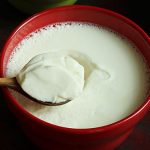 A custard-like product made by fermenting concentrated whole or skimmed milk with or without added fruits or flavorings.
A custard-like product made by fermenting concentrated whole or skimmed milk with or without added fruits or flavorings.
In the early part of the seventeenth century, an English travel writer reported that the people in Turkey were fond of a dish of sour milk called yoghurd. In the succeeding centuries, yoghurd was followed by many other attempts to render the original Turkish word into English, including yaghourt, yooghort, and yohourth. The matter has still not been settled, as yogurt is sometimes still challenged by yoghurt (the latter, in fact, is the better rendering of the Turkish source). The bacterium responsible for turning milk into yogurt is called streptococcus thermophilus, literally meaning twisted-berry heat-lover; biologists bestowed this name upon the berry-shaped bacteria because they need high temperatures to thrive and because they arrange themselves in twisted chains.
Whole milk with varying amounts of added milk solids.
Sour milk curdled with one of the lactic acid producing bacilli, such as Lactobacillus acidophilus or Lactobacillus bulgaricus. It contains all the protein, fat, calcium, and vitamins of the original milk, and is therefore a nutritious food, but there is no evidence that it has any unique beneficial properties of its own. In countries where standards of hygiene are low, it has the advantage of having been sterilized by boiling and is therefore unlikely to be contaminated with dangerous micro-organisms.
A form of curdled milk created by culturing milk with Lactobacillus bulgaricus. Yogurt is a source of calcium and protein that is palatable. It may be better tolerated than milk by persons with lactase deficiency. Yogurt with live bacterial cultures is probiotic it may be useful for replenishing intestinal flora that have been eradicated by antibiotics.
The given passage pertains to a specific type of food preparation, which involves fermented and condensed milk. This preparation is comparable to similar dairy products such as kumiss and kefir. Its consistency may vary, but it is typically akin to that of heavy cream, ranging from semi-solid to fluid. This food is consumed either on its own or as a spread, and may also be flavored and served as a beverage. It is a frequently utilized ingredient in Middle Eastern and Indian cuisine. It should be noted that this food item may be spelled in several ways, including yaghoust, yogart, yoghurt, and yohourt.
Believed to trace its origins to the nomadic tribes of Eastern Europe, yogurt has a rich history. Initially, it took the form of a beverage, crafted through the fermentation of lactose (milk sugar) by the inherent microorganisms present in milk. This natural process led to the conversion of lactose into lactic acid, resulting in a delightfully tangy yogurt. In the absence of refrigeration, where acid production remains unrestricted, an exceptionally sour yogurt emerges as a testament to its traditional preparation methods.
